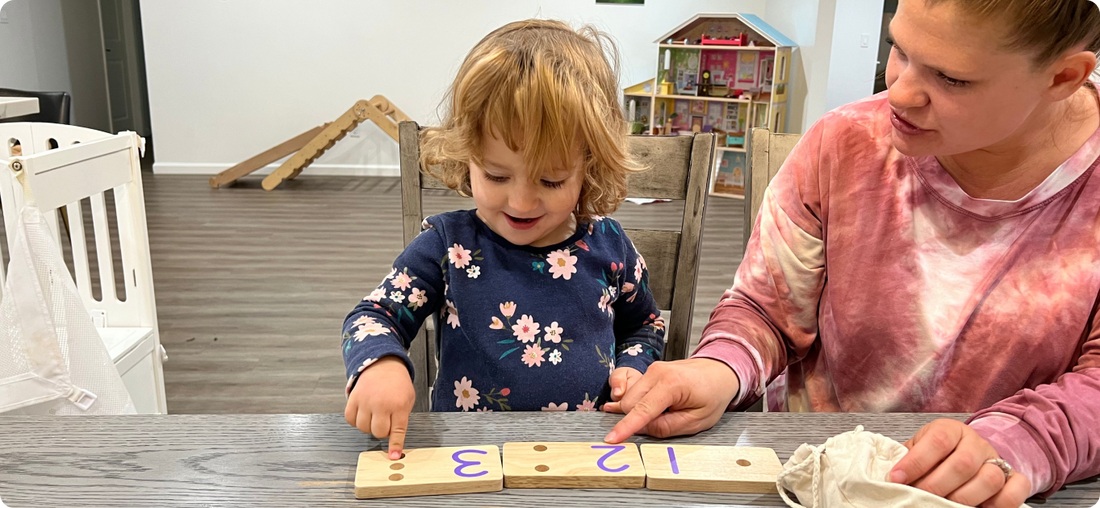You’ve been using the Montessori method for a while now, and every day you see the benefits it gives you and your family.
The sense of confidence and independence its practices give your child.
The contentment those practices give you knowing you’re laying a strong foundation for your child.
Your infant is now a toddler, and you’ve heard a little about the concept of one-to-one correspondence.
You know it’s part of Montessori’s math foundation.
But you’re still not exactly sure what it is, how to introduce it to your child, or what tools you need.
Here are 4 things you need to know about one-to-one correspondence. 
1. One-to-one correspondence is more than counting.
At a very young age, most children can count to 10. They do it from memory. They’ve heard their parents and other adults do it, and they’re repeating it.
Counting and one-to-one correspondence are different. Counting is listing numbers, and mathematical problem-solving isn’t possible unless children understand what those numbers actually mean.
One-to-one correspondence means understanding an item can only be counted once and assigning a number to that item. It’s counting while pointing to or touching an object. And while many traditional early childhood learning programs skip this concept, it’s fundamental in Montessori math.
One-to-one correspondence is sometimes referred to as rational counting. It’s a much more complex skill than rote counting (reciting numbers in order from memory). Children are ready to begin exploring one-to-one correspondence and assigning values to numbers at about 18 months to 2 years old.
2. Start with concrete objects first.
As with all Montessori concepts, introduce your child to one-to-one correspondence with concrete objects first. Children need to touch and feel to understand the concept of quantity before they can understand how numbers fit with the skill.
As a parent, modeling is an easy and effective way to introduce your child to one-to-one correspondence. Point and count out loud–the flowers in the vase, the toothbrushes on the bathroom counter. Use items that are identical to each other whenever possible. This will help eliminate confusion for children as they begin to explore value.
In one-to-one correspondence, the order of the numbers matters. The order of the objects counted doesn’t. Start with 3 objects and move up. Your child sets the pace for their learning; the goal is concept mastery, not speed. Resist the urge to correct them when they make a mistake. This is part of the learning process. Correcting a child lowers their energy for the activity and can be interpreted as punishment.
Transferring or moving things from one place to another is an additional way to introduce one-to-one correspondence concretely. Model counting and moving objects from one tray to another, then have your child do it. If they skip a number or say a number twice, model it again. Want to add to the fun? Have them use tongs for a fine motor skill boost.
During the concrete stage of one-to-one correspondence, children learn the same numbers can be assigned to different things. There can be 4 apples in a bowl and 4 children in a classroom. This is another fundamental concept for math.
While your child is in the concrete stage of learning one-to-one correspondence, don’t use any written representation of numbers. Once your child has mastered one-to-one correspondence with objects, they’re ready to move on to abstract number symbols.
Your child is usually ready to move on to the abstract concept around age 3 or 4.
3. Next, move on to the abstract.
Once your child has mastered concrete one-to-one correspondence, they’re ready for abstract one-to-one correspondence. That means introducing written numbers. Keep in mind numbers are symbols, and in this case, those symbols represent quantity.
Your child can count and transfer a group of objects one at a time, so the next step is to bring in the numbers corresponding to those quantities. Your child can count 8 rocks, so now it’s time to include the numeric symbols for 1- 8.
Understanding the abstract concept of one-to-one correspondence lays the groundwork for all of your child’s subsequent math skills. It’s a prerequisite for any future math–adding, subtracting, multiplying, and dividing.
One-to-one correspondence will become automatic, and your child won’t even think about what they’re doing. But they’ll have learned number sense in a way that equips them for much deeper problem solving later. Rote counting alone won’t do that.
So what tools do you need to get started?
4. Use a counting peg board.

Counting peg boards are a great next step for your child as they explore this stage of their one-to-one correspondence understanding. With a peg board, your child matches the appropriate number of pegs to the corresponding number on the board.
Peg boards are a classic Montessori learning instrument because they’re self-correcting. Self-correction is very important because your child gets immediate feedback about whether or not they’ve matched the right number of pegs with the correct number.
They don’t require adult interaction, so they build your child’s confidence and independence. With a counting peg board, your child identifies number patterns, and pattern recognition is another fundamental Montessori skill.
Montessori & Me’s Counting Peg Board is the perfect tool for learning one-to-one correspondence and developing your child’s number recognition skills.
Our set consists of 10 wooden number boards with a wooden box and 57 counting pegs.
It has a canvas drawstring bag for convenient storage, and its design makes it work well as a permanent piece and as a grab-and-go toy.
We made our counting board and pegs to last. They’re made from sustainably-harvested rubberwood and conform to safety standards.
The smooth finish won’t scratch little hands, and the child-safe lacquer finish makes cleaning a breeze.
Montessori & Me’s Counting Peg Board is perfect for home or the classroom.
Continue giving your child the best and get yours today.




